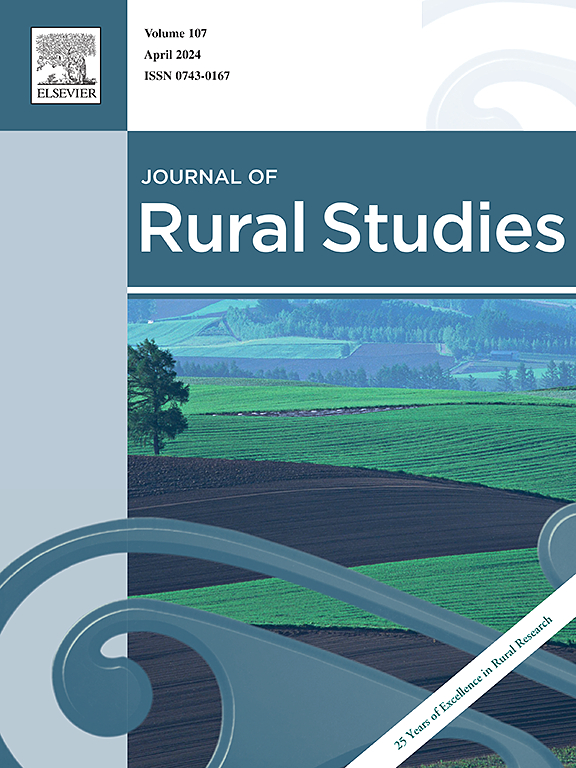How to tackle landownership challenges in Finnish agriculture: Types of landowners and their views on ownership, land tenure and improvement measures
IF 5.1
1区 社会学
Q1 GEOGRAPHY
引用次数: 0
Abstract
A rapid change in farm structure has increased non-farmer landownership during Finland's EU membership. Farm sizes have grown, and there is a clear need to generally improve the functioning of the land and rental market. These improvements include optimising land division, and promoting the appropriate and efficient use of the cultivated field area with the help of new technologies. In Finland, although farming landowners own a significant proportion of agricultural land, a considerable share is also leased from non-farming landowners. Leased land, however, causes short-sightedness regarding maintaining and improving soil fertility and improving the farming sector in general. This study analyses the main motives and values of Finnish farming and non-farming landowners regarding landownership. It examines how these motives vary among different landowner types, their experiences with land tenure and related challenges, and their thoughts and plans for improving land management. We adopted a mixed methods research design to gather the data. First, we conducted nine landowner interviews and a literature review to prepare for the quantitative survey. Second, survey data from 248 landowners was collected through structured telephone interviews in February 2021. To form the landowner groups, we applied principal component analysis (PCA) and cluster analysis (CA). The results show that agricultural landownership is motivated by different values depending on whether the landowners are from farming or non-farming backgrounds. Through PCA, we identified three components of landowners' motives: 1) livelihood, active farming, and an effective farm structure; 2) continuity, family farming, and ownership; and 3) concerns in developing property structure. Through clustering, these were interpreted as four types of landowners: 1) optimisers of arable land; 2) rational developers; 3) continuity seekers of family farming; and 4) preservers of ownership. In general, as farming seeks economies of scale through larger units, attaining the optimal techno-economic farm size may be challenging in the future due to a lack of arable land for purchase or rental in Finland's typical mixed agriculture-forest landscapes.
如何解决芬兰农业的土地所有权挑战:土地所有者的类型及其对所有权、土地使用权和改善措施的看法
在芬兰成为欧盟成员国期间,农业结构的快速变化增加了非农民的土地所有权。农场规模不断扩大,显然需要普遍改善土地和租赁市场的运作。这些改进包括优化土地划分,以及在新技术的帮助下促进耕地面积的适当和有效利用。在芬兰,虽然农业土地所有人拥有很大比例的农业土地,但也有相当一部分是从非农业土地所有人那里租赁的。然而,租赁土地在维持和改善土壤肥力和改善整个农业部门方面造成了短视。本研究分析了芬兰农业和非农业土地所有者在土地所有权方面的主要动机和价值观。它考察了这些动机在不同土地所有者类型之间的差异,他们在土地所有权和相关挑战方面的经验,以及他们改善土地管理的想法和计划。我们采用混合方法的研究设计来收集数据。首先,我们进行了9次土地所有者访谈和文献综述,为定量调查做准备。其次,在2021年2月通过结构化电话访谈收集了248名土地所有者的调查数据。采用主成分分析(PCA)和聚类分析(CA)对土地所有者群体进行分析。结果表明,农业土地所有权的价值动机不同,取决于土地所有者是农业背景还是非农业背景。通过主成分分析,我们确定了土地所有者动机的三个组成部分:1)生计、积极耕作和有效的农场结构;2)连续性、家庭农业和所有权;3)发展产权结构的关注点。通过聚类分析,将其解释为四种类型的土地所有者:1)耕地优化者;2)理性开发者;3)家庭农业的连续性寻求者;4)所有权保管人。一般来说,随着农业通过更大的单位寻求规模经济,由于芬兰典型的农林混合景观缺乏可供购买或租赁的耕地,未来实现最佳技术经济农场规模可能具有挑战性。
本文章由计算机程序翻译,如有差异,请以英文原文为准。
求助全文
约1分钟内获得全文
求助全文
来源期刊

Journal of Rural Studies
Multiple-
CiteScore
9.80
自引率
9.80%
发文量
286
期刊介绍:
The Journal of Rural Studies publishes research articles relating to such rural issues as society, demography, housing, employment, transport, services, land-use, recreation, agriculture and conservation. The focus is on those areas encompassing extensive land-use, with small-scale and diffuse settlement patterns and communities linked into the surrounding landscape and milieux. Particular emphasis will be given to aspects of planning policy and management. The journal is international and interdisciplinary in scope and content.
 求助内容:
求助内容: 应助结果提醒方式:
应助结果提醒方式:


